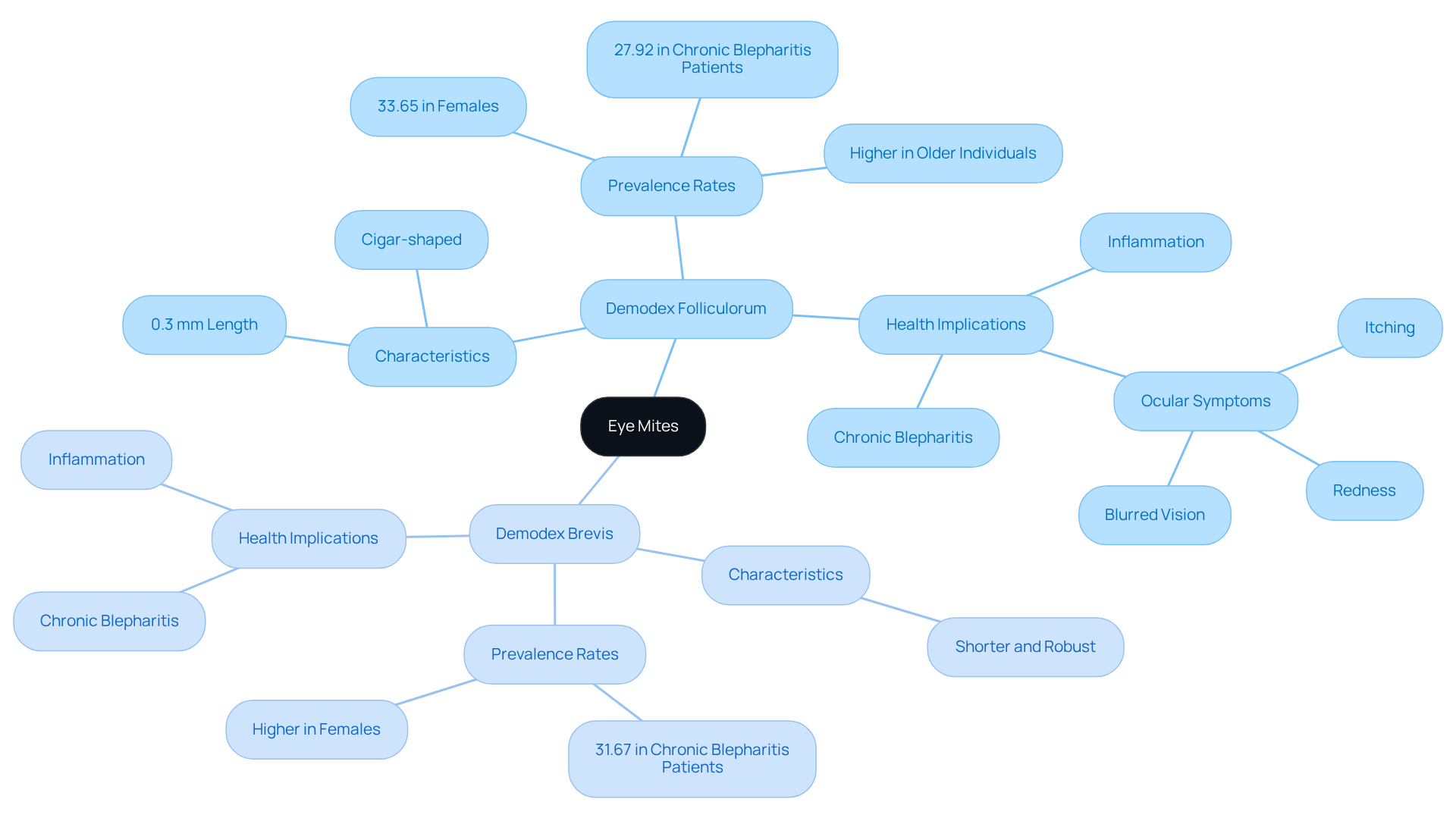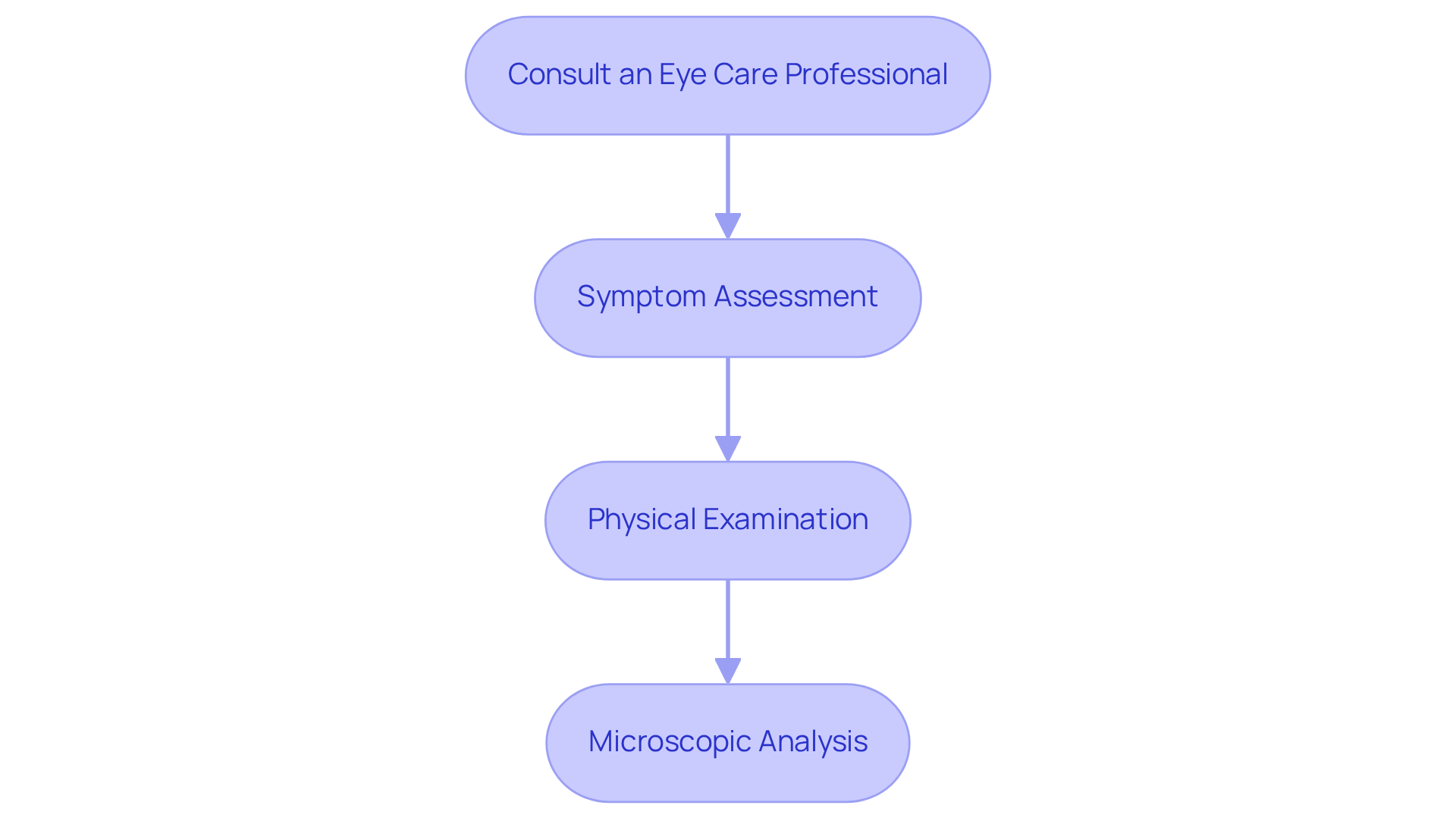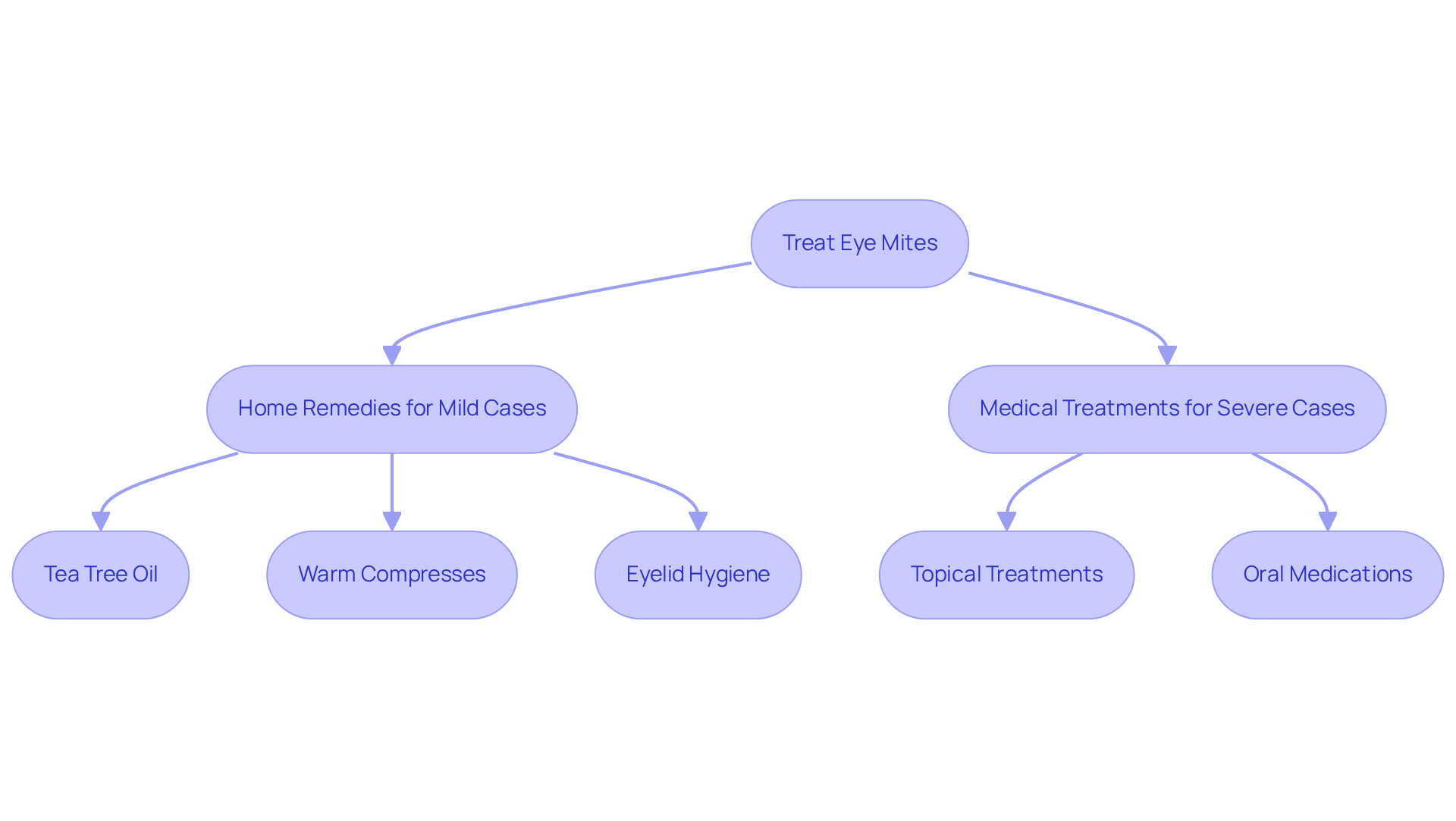Posted by: Northwest Eye in General on July 6, 2025
Overview
This article provides a compassionate overview of how to identify and treat eye mites effectively. We understand that dealing with such issues can be concerning, which is why recognizing symptoms and diagnosing infestations is crucial. We aim to support you by detailing the different types of eye mites and their associated symptoms. Additionally, we explore both home remedies and medical treatments, emphasizing the importance of consulting a professional for tailored care. Remember, you are not alone in this journey, and seeking help is a positive step towards relief.
Introduction
Understanding the hidden world of eye mites can be both alarming and enlightening. We recognize that these microscopic organisms, often overlooked, can significantly impact your eye health, leading to discomfort and irritation. In this article, we will explore critical steps for identifying and treating eye mites, equipping you with the knowledge to recognize symptoms and discover effective remedies. It’s common to feel concerned when these tiny pests become a significant issue for your eye health. Together, we will navigate the complexities of treatment options, ensuring you feel supported every step of the way.
Understand Eye Mites: Types and Characteristics
Eye mites, specifically folliculorum and brevis, are tiny organisms that live in the hair follicles and sebaceous glands of the human face, especially around the eyelashes. We understand that learning about these mites can be concerning. Folliculorum mites are cigar-shaped, measuring approximately 0.3 mm in length, while brevis mites are shorter and more robust. These tiny organisms are generally regarded as a typical part of the skin’s microbiome, with prevalence rates differing considerably among populations. Studies indicate that the overall prevalence of eye mites can range from 17% to as high as 100% in certain demographics, with higher rates observed in older individuals and those with specific skin conditions, such as chronic blepharitis.
It’s common to feel worried about the implications of having these pests. Research has shown that large populations of eye mites can lead to several skin problems, including inflammation and irritation. In fact, a study found that eye mites, specifically Demodex infestation, were present in 79.2% of patients with chronic blepharitis, which correlated with increased ocular symptoms like itching, redness, and blurred vision. Blurred vision may also arise from other underlying conditions linked to overgrowth, such as cataracts, diabetic retinopathy, dry eyes, or uncorrected refractive errors. Dermatologists stress that although eye mites are generally harmless tiny creatures, their excessive proliferation can disturb the skin’s equilibrium, possibly resulting in issues like rosacea and chronic blepharitis.
Understanding the characteristics of these tiny creatures is essential for identifying . Eye mites, including Demodex folliculorum, primarily reside in the lash follicles, while Demodex brevis burrows into sebaceous and meibomian glands. This differentiation is crucial for effective diagnosis and treatment, as the presence of these pests can worsen eyelid inflammation and lead to ocular discomfort, including blurred vision. If you notice signs like blurred vision or irritation, we encourage you to seek professional medical assistance to address these issues promptly. Remember, we are here to help you through this process.

Recognize Symptoms of Eye Mite Infestation
Infestations of eye mites can be quite distressing, often leading to ongoing signs such as itching, redness, and swelling of the eyelids. We understand that these symptoms can be uncomfortable and concerning. Approximately 60% to 70% of patients with [dry eye](https://pmc.ncbi.nlm.nih.gov/articles/PMC7981278) also experience signs related to eye mites and [Demodex blepharitis](https://pmc.ncbi.nlm.nih.gov/articles/PMC10351901). This condition may include:
- A gritty feeling in the eyes
In more severe cases, these signs can escalate to:
- Blurry vision
- Loss of eyelashes
Recognizing these signs early is crucial, as untreated infestations of eye mites can lead to complications like blepharitis or conjunctivitis.
At Northwest Eye, we are here to help you through this process. The evaluation of dry eye includes thorough testing methods such as LipiView® and Tear Osmolarity, which assess the quality and volume of tears. Our ophthalmologists stress that being aware of these signs can enable prompt intervention, ultimately enhancing your outcomes and quality of life. Furthermore, innovative therapies such as LipiFlow® and BlephEx® are readily available to effectively address both dry eye and blepharitis issues. You are not alone in this journey, and we are committed to providing the support you need.
Diagnose Eye Mites: Steps to Confirm Infestation
To effectively diagnose an , we recognize that it can be a cause for concern. Here are some essential steps to guide you through this process:
- Consult an Eye Care Professional: We recommend scheduling an appointment with an ophthalmologist or optometrist who specializes in eye health. This is an important first step in addressing your concerns.
- Symptom Assessment: When you visit, offer a thorough description of your symptoms, including their duration and intensity. This information is crucial for an accurate diagnosis. Frequent signs of blepharitis caused by eye mites include crusty or sticky eyelashes, irritation, and inflammation. Additionally, symptoms like blurred vision or eye discomfort may indicate underlying conditions that require attention.
- Physical Examination: Your eye care specialist will perform a thorough assessment of your eyelids and eyelashes, looking for signs of infestation such as cylindrical dandruff or crusting. These are typical indicators of blepharitis caused by eye mites. This examination is critical, as studies show that nearly 57.7% of patients visiting eye care clinics may have Demodex blepharitis. This underscores the necessity for thorough screening for eye mites during routine eye exams.
- Microscopic Analysis: In specific instances, the physician might remove a few eyelashes for microscopic evaluation to verify the existence of small parasites. As William B. Trattler notes, ‘Demodex blepharitis, based on the pathognomonic finding of collarettes, is common and likely underdiagnosed among patients seeking eye care.’
Remember, if you experience any concerning symptoms, it is essential to seek professional medical help immediately. We are here to help you through this process.

Treat Eye Mites: Home Remedies and Medical Solutions
Caring for eye mites involves both home remedies and medical options, tailored to the severity of the infestation. We understand that dealing with these issues can be concerning, so here are some gentle home remedies for mild cases:
- Tea Tree Oil: This natural treatment, when blended with a carrier oil and applied to the eyelids, has shown effectiveness against skin parasites. Research indicates that tea tree oil can significantly reduce the population of Demodex parasites, with a mean difference of 0.70 in reduction observed in clinical trials. Many patients favor this option for its natural properties.
- Warm Compresses: Applying warm compresses to your eyelids can help loosen crust and debris, providing soothing relief and promoting eyelid hygiene.
- Eyelid Hygiene: Regularly cleansing your eyelids with eyelid scrubs or diluted baby shampoo can help eliminate excess oils and debris, thereby decreasing the chances of eye mites.
For more severe infestations, medical treatments may be necessary. It’s common to feel overwhelmed, but there are effective options available:
- , such as prescription creams or ointments containing acaricides, can effectively eliminate eye mites. Clinical trials have shown that these treatments can lead to significant improvements in symptoms and mite eradication rates, with some studies reporting high efficacy in reducing symptoms associated with Demodex blepharitis.
- Oral Medications: In cases of severe infestation, oral medications may be prescribed to comprehensively address the issue.
It is crucial to consult with an eye care professional before starting any treatment to ensure it is suitable for your specific condition. Eye care experts emphasize the importance of personalized treatment plans, as individual responses to remedies can vary significantly. Remember, as noted by professionals in the field, “The effectiveness of treatments can differ based on individual patient factors, making personalized care essential.” We are here to help you through this process.

Conclusion
Understanding eye mites, particularly Demodex folliculorum and Demodex brevis, is essential for maintaining your eye health and overall skin balance. We recognize that these microscopic organisms are a natural part of your skin’s microbiome, but their overgrowth can lead to various uncomfortable symptoms and conditions, such as chronic blepharitis and ocular discomfort. It’s common to feel concerned if you notice signs of infestation, such as itching, redness, or blurred vision. Recognizing these symptoms is crucial for early intervention and effective treatment.
We want to emphasize the importance of consulting eye care professionals for an accurate diagnosis and treatment. Key steps in this process include:
- A thorough symptom assessment
- A physical examination
- Potentially microscopic analysis to confirm the presence of eye mites
Treatment options range from gentle home remedies, like tea tree oil and warm compresses, to more intensive medical solutions, ensuring a tailored approach based on the severity of your situation.
Ultimately, awareness and proactive measures are vital in managing eye mite infestations. By understanding the characteristics, symptoms, and treatment options available, you can take charge of your eye health. If symptoms arise, we encourage you to seek professional help, as timely intervention can lead to better outcomes and an improved quality of life. Embracing these steps not only addresses the immediate concerns of eye mites but also fosters long-term eye health and comfort. Remember, we are here to help you through this process.
Frequently Asked Questions
What are eye mites and where do they live?
Eye mites, specifically Demodex folliculorum and Demodex brevis, are tiny organisms that live in the hair follicles and sebaceous glands of the human face, particularly around the eyelashes.
What are the characteristics of folliculorum and brevis mites?
Folliculorum mites are cigar-shaped and measure approximately 0.3 mm in length, while brevis mites are shorter and more robust.
How common are eye mites among different populations?
The prevalence of eye mites can range from 17% to as high as 100% in certain demographics, with higher rates observed in older individuals and those with specific skin conditions, such as chronic blepharitis.
Can eye mites cause any health issues?
Yes, large populations of eye mites can lead to skin problems such as inflammation and irritation. They have been found in 79.2% of patients with chronic blepharitis, which is associated with symptoms like itching, redness, and blurred vision.
What other conditions can be linked to the overgrowth of eye mites?
Overgrowth of eye mites can be linked to other underlying conditions such as cataracts, diabetic retinopathy, dry eyes, and uncorrected refractive errors.
What should I do if I notice signs of eye mite infestation?
If you notice signs like blurred vision or irritation, it is recommended to seek professional medical assistance to address these issues promptly.
Are eye mites harmful?
Eye mites are generally considered harmless, but their excessive proliferation can disturb the skin’s equilibrium and potentially lead to issues like rosacea and chronic blepharitis.






